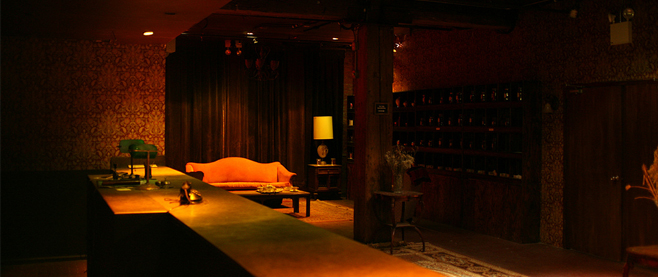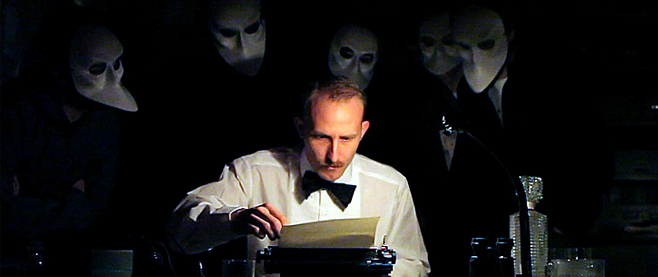
Macbeth Does Murder Sleep!
Warning: this piece recounts in detail my experiences at a recent performance of Punchdrunk’s Sleep No More, a unique adaptation of Macbeth currently running in Manhattan, and attempts to deconstruct those experiences. If you have any intention of going to see the show yourself, I urge you to not read on.
———
It begins before you get there, with the story of a hotel.
Completed in 1939, the McKittrick Hotel was intended to be New York City’s finest and most decadent luxury hotel of its time. Six weeks before opening, and two days after the outbreak of World War II, the legendary hotel was condemned and left locked, permanently sealed from the public. Until now…
You enter the hotel through massive metal doors and wind your way through dark corridors, past a coat check and ticket desk (where you are given a playing card – mine is, strangely, the 13 of Diamonds) and into an Art Deco-inspired jazz club. A sleazy, intoxicated fellow in a rumpled tuxedo flirts aggressively with the crowd in between calling out cards. When your number is called you move off to another room.
There, you are given an unadorned bauta mask and are told to wear it at all times and to remain silent within the hotel. You pile into an elevator, where the operator tells you, just before the doors slide open, that fortune favors the bold. Those are the last words you hear for three hours.
———
I step out onto the fifth floor and make my way through a series of rooms that feel more like a sanitarium than a hotel, with large dormitories, surgical equipment and medical charts scattered here and there. In an operating theater, an older man crouches over the operating table, fitfully scrawling lines of words in chalk across the wooden surface. I move on, exploring for a long time, determined to get an understanding of the floor’s layout, in case it is important later. The next time I pass through the operating theater, the old man is gone but the table filled with cramped writing. I wander by a third time, and the table is now mostly clean and the old man was back to writing, but the exact same nonsense and the exact same way.
I walk through a forest, past a padded room and take the stairs down to the fourth floor, where the rooms are filled with taxidermy and strange curios. One room is filled with drying herbs, specimen jars and magical symbols – a witch’s room. I turn right and find myself on a cobbled street lined with shops. A young man is there, vomiting into a corner before stumbling drunkenly off. Many of the other masked spectators followed him, but I stroll into the shops.
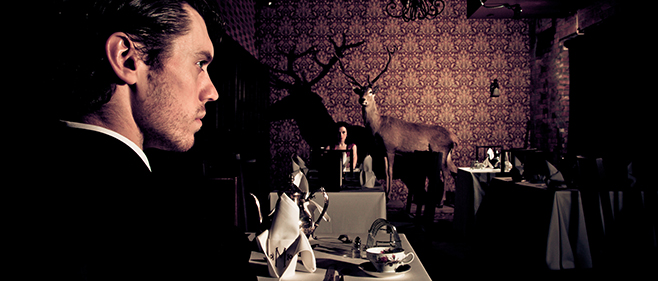 Soon after, I begin to hear the incongruous thump of electronic dance music. As I move to investigate the sound, another maskless man runs past me at breakneck speed, nearly knocking me over. His destination is a bar that looks very much like my conception of a speakeasy. Other actors pour in, dancing to the music. The room quickly grows hot as the dancers throw themselves recklessly around and soon the darkness is only illuminated by a pulsing strobe. The women, the witches, begin to shed their clothes. My recollection of what happens next in the phantasmagoria, with the baby and the blood and the man with the head of a goat, is extremely unclear.
Soon after, I begin to hear the incongruous thump of electronic dance music. As I move to investigate the sound, another maskless man runs past me at breakneck speed, nearly knocking me over. His destination is a bar that looks very much like my conception of a speakeasy. Other actors pour in, dancing to the music. The room quickly grows hot as the dancers throw themselves recklessly around and soon the darkness is only illuminated by a pulsing strobe. The women, the witches, begin to shed their clothes. My recollection of what happens next in the phantasmagoria, with the baby and the blood and the man with the head of a goat, is extremely unclear.
Sleep No More is a confusing and claustrophobic experience. While everyone I have spoken to about the performance has been generally positive about it, a large majority of them were left feeling like they missed much and that the overall experience could have been improved had the fractured narrative been even incrementally more cohesive.
I don’t agree. Like in a video game, Sleep No More is a balancing act between narrative and ludic elements (the latter being anything involving interactivity or personal choice). Had the experience been more ludic, it would have become a kind of interactive museum. If the balance instead shifted towards narrative, the performance would have inched closer and closer to a conventional stage play with no audience participation.
For all the ludic elements, and there are plenty – letters to read, desks to rummage through, artifacts to examine – the story of Sleep No More is actually very strong. My acquaintances who say otherwise, unfortunately, simply spent most of their time searching for the wrong one.
The third floor begins to feel much more like a hotel, with plenty of bedrooms to explore. The large bedroom of the Macbeths is here, lined with French doors and overlooking gardens and ruined buildings. I see them arguing through pantomime and violent interpretive dance. Macbeth storms off and his wife looks pleased with herself. I decide to investigate the garden.
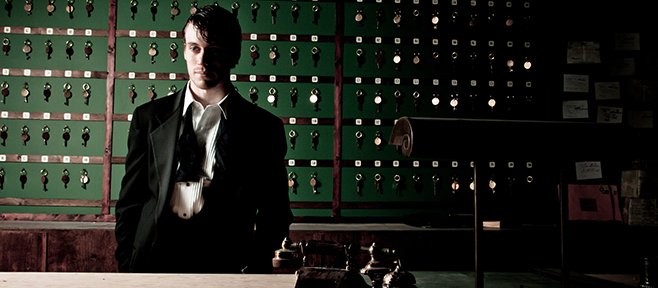 When I return, Lady Macbeth is gone. I move through the bedroom, past the bathtub, to the stairwell at the far side, only to have Macbeth, hands covered in blood, run directly into me and push past back into the bedroom. Duncan, wherever he may be in the hotel, is dead.
When I return, Lady Macbeth is gone. I move through the bedroom, past the bathtub, to the stairwell at the far side, only to have Macbeth, hands covered in blood, run directly into me and push past back into the bedroom. Duncan, wherever he may be in the hotel, is dead.
Lady Macbeth materializes from the shadows and washes the evidence of her husband’s evil deed away. They retire to bed, but Macbeth’s guilty mind does not let him sleep and he stalks off again. Lady Macbeth also has a heavy conscience. She awakens to find her hands covered with blood that only she can see. She becomes hysterical as she tries to wash them clean.
I slip downstairs.
It comes down to a matter of perspective. Most people see the threads of Macbeth unfolding around them and are moved to wonder who the actors are and how the disparate sets and scenes connect together to mirror the traditional flow of the story they already know. Viewed through this lens, Sleep No More is a bit of a mess. This perspective ignores a very important aspect of the narrative – your own role within it.
Sleep No More is not the story of the Macbeths and the dark deeds they did in pursuit of power, though it does have things in common with Shakespeare’s play. Nor is it the story of a family of hoteliers in the late 1930s and the tragedy that befell them, though they do share the environment with you.
No, Sleep No More is the story of the night you spent at a haunted hotel and the things you found there.
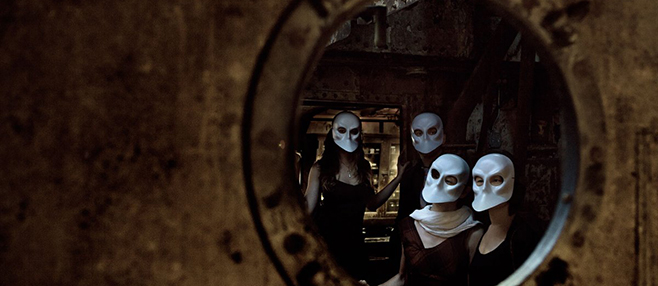 The second floor is dominated by the hotel lobby and dining room. Unlike the other floors, which I explored amply before being disturbed by unusual occurrences, this time I am immediately enveloped in action. Characters move through the lobby at dizzying speed, fighting, skulking, drinking and hiding.
The second floor is dominated by the hotel lobby and dining room. Unlike the other floors, which I explored amply before being disturbed by unusual occurrences, this time I am immediately enveloped in action. Characters move through the lobby at dizzying speed, fighting, skulking, drinking and hiding.
Until suddenly we all, masked observers and actors alike, are moving in a mass to a balcony overlooking the ballroom on the first floor. The actors all reappear onstage around a banquet table, feasting in a slow-motion tableau. As the lights change and smoke fills the room, the revelers turn quarrelsome. They drag Macbeth onto the tabletop. As the music rises to a climax, a noose is slipped over his head and he is pushed off the table. The music, and Macbeth, ends with a sickening thud.
As we file out, I could hear someone in the distance singing ‘Come on, Get Happy.’
———
At least three violent deaths occurred at the McKittrick Hotel in a short period of time, murders that were fueled by the lust, betrayal and desperation of its inhabitants. Those events, so terrible and traumatic, left a stain on the place, one that permeated so deeply that it still plays out, over and over again, night after night, some seventy years later.
Like any haunting, we see the echoes of those events. Shades slide past us, oblivious to our presence, reenacting moments that for them are some of the darkest in their lives, but for us have no context. We can interpret their actions and piece together some scant meaning from the objects they have left behind, but we can never really know what happened in that hotel, any more than we can know the truth about any event shrouded in the past.
The story of Sleep No More isn’t something we receive passively, it is something we actively make out of what we witness and how we react to it.
The narrative is us, and we are haunted.




